Article by the Drummond Team
In Russia and Eastern Europe, kettlebell lifting is an international sport with local, national and world championships. However, they have become a piece of equipment found in many gyms, health clubs or studios. Kettlebells are a fantastic piece of equipment for development of dynamic strength and endurance in both a class situation and on a one to one in the gym. Kettlebells are well established training tools. They’re used by athletes, mixed martial artists, power lifters, military forces and everyday gym and class goers. They provide a training system that is highly adaptable, cheap and easy to learn, and develops certain techniques that may be useful in other training modalities. The very functional nature of swinging a kettlebell means it is suitable for nearly everyone at the correct weight of course.
Taking a Closer Look
Taking a closer look at a kettlebell we can see three main parts: the handle, the horns and the bell.
Handle
Horn
Bell
Kettlebell exercises or ‘lifts’ are very effective for various physical fitness goals including developing strength, power, muscle endurance, flexibility, motor skills and a good body composition.
Benefits
Kettlebells provide an effective, functional and adaptable training device for fitness professionals.
“The kettlebell has been for years a very important factor in developing strength, yet the modern weightlifter rarely, if ever, uses it. …. . I find the kettlebell one of the most useful and fascinating of training apparatus. There are so many apparently simple exercises and lifts one can perform……
Possibly another reason so few weight lifters use the kettlebell is that they can only press about two thirds as much with this form of a weight than they can with a barbell.
However, those that do use the kettlebell will be more than repaid in development and strength”.
Kettlebells can be used to develop and improve:
- strength and power
- hypertrophy
- muscle endurance
- functional abilities
- core function
- sports performance
- active flexibility
- body composition
- cardiovascular fitness
Starting Weights
The recommended starting kettlebell weight for men should be around 16 kg, progressing to 20-24 kg or more depending on the exercise.
The recommended starting weight for women should be around 8 kg, progressing to 10- 12 kg or more depending on the exercise.
The size of the kettlebell will also be dictated by whether the training goal is the acquisition of cardiovascular fitness, muscle endurance, strength or power.
Kettlebell user Starting weight
Average lady 8 kg
Strong lady 12 kg
Average gentleman 16 kg
Stronger than average 20 kg gentleman
Very strong gentleman 24 kg
Strength & Power
Kettlebell exercises promote nervous system adaptations that increase strength and mobility while developing motor skills such as coordination and balance.
The thick handle of kettlebells means you need a strong grip and using them is a very effective way of developing grip and forearm strength.
The value of kettlebell training for developing grip strength is well demonstrated by kettlebell performer John Brookfield who holds a world record for bending a 20-foot half inch diameter (12mm) steel bar to fit into a small suitcase in 29 seconds.
There are a number of lifts used in kettlebell training that target the posterior kinetic chain. The main muscles here are the:
- erector spinae
- gluteus maximus
These are some of the biggest and strongest muscles involved when performing big lifts. The posterior chain is important for sports performance because it’s fundamental to generating forward motion and acceleration. The posterior chain drives performance in jumping, sprinting, throwing, kicking and punching.
Many kettlebell lifts require the production of strength at speed. The ‘hip snap’ technique is vital for developing this power and we rely on it in certain kettlebell lifts such as the swing.
The hip region can be considered the ‘power zone’ where we generate the forward momentum and acceleration that drives many kettlebell lifts.
Hypertrophy
Hypertrophy is an increase in the size of skeletal muscle resulting from the increased size of individual muscle fibres. The primary driving force that initiates skeletal muscle hypertrophy is increased muscular tension, typically generated through resistance exercise. Kettlebells provide the lifter with the resistance necessary to provide muscular tension and can be adapted to conform to hypertrophy training parameters.
Muscle Endurance
Kettlebell lifts can be performed for a higher number of repetitions to promote muscular endurance and a more cardiovascular effect. Programmes can be designed to emphasise muscle endurance by using workout structures such as circuits.
Many of the exercises involve integrated movements, which means strengthening groups of muscles rather than just one at a time. There are also many exercises that include the different planes of motion:
- sagittal (forwards and backwards)
- frontal (side-to-side)
- transverse (rotation).
Kettlebell lifts develop whole body strength and improve motor skills for many everyday activities and sports.
Core function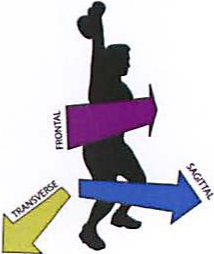
Core function is the ability of your trunk to support the effort and forces from your arms and legs. Kettlebells can improve the function of the core because it has to support and stabilise the trunk during kettlebell lifts. This improvement in core function can play a significant role in preventing conditions such as lower back pain.
Sports performance
The dynamic control needed to accelerate and decelerate a kettlebell swung at speed relates to many sports and helps develop shoulder and hip strength, stability and flexibility. Kettlebells are particularly good at strengthening and dynamically loading the hip muscles. They also improve coordination and agility.
Active flexibility
Having a good static range of motion may be an indicator of flexibility, but doesn’t necessarily transfer to the flexibility requirements of everyday movement or sports performance.
Many kettlebell lifts are completed through larger ranges of motion than those provided by other training methods and this will encourage more movement-based flexibility.
Example of a basic whole-body muscular endurance kettlebell routine
Warm-up
| Exercise | Speed/rpm | Incline/level | Duration | Notes |
| CV: walk.to Jog | 4-9 kph | RPE | 5 mins |
Flexibility: All over body dynamic stretches of 8-10 reps each Drills: Squats, bridge, plank, press ups
Main session
| Exercise | Weight | Set x reps | Rest | Notes | |
| Double KB swings | 2 X 12-20 | 30,-60 secs | Can also be done in a circuit format | ||
| One-arm KB press | 2 X 12-14 | 30-60 secs | |||
|
|
KB front squats | 2 X 12-14 | 30-60 secs | ||
| • | One-arm kettlebell
rows lunge stance |
2 X 12-14 | 30-60 secs | ||
| Turkish get up
(TGU). |
1 X 6-12 | 30-60.secs |
Cool Down
Five of the Top 20 Kettlebell Exercises
1. The Swing
The swing is the most traditional kettlebell exercise, partly due to the fact that you simply cannot perform it as effectively with any other piece of equipment. It will develop strength in the posterior chain, firming glutes and thighs and strengthening the core.
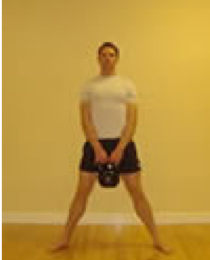


Muscles used:
Glutes
Hamstrings
Erector spinae
Start position
Deadlift the kettlebell from the floor with both hands. Stand with feet slightly wider than shoulder width apart with a neutral spine and pelvis and tight glutes.
Initiate the movement
Begin the movement by thrusting forward with the hips to push the kettlebell away from you. Allow the weight to fall and throw it backwards between the legs whilst lowering the body and shifting the backside to the rear.
Lifting phase
Squeeze the glutes to drive the hips forwards and upwards. Take care not to initiate this phase of the movement by lifting from the shoulders, as this will place undue stress through the low back. The kettlebell will travel in an arc until the arms are parallel to the ground, at which point the knees should be locked out and the glutes squeezed tight to bring the hips forward. At the top of the movement the weight should feel as though it “hangs” in the air for a fraction of a second before starting its decent.
Lowering phase
Allow the kettlebell to fall naturally, then sit back into the heels and push your backside to the rear. Keep the chest high and head up, maintaining a neutral spine throughout. Guide the kettlebell between the legs, your forearms resting on your adductors. The next repetition is started from this position, creating a smooth, fluid action.
LIFT VARIATIONS
-
- One hand swing
- Double kettlebell swing
- Alternating swing
- Rotating / travelling swing
2. The snatch
Of all the kettlebell exercises the snatch is possibly the most effective and challenging. It requires a high degree of muscular co-ordination as well as an explosive movement from the hips.
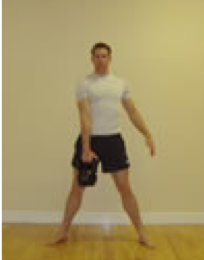


Muscles used
Glutes, Hamstrings, Erector spinae, Trapezius, Deltoids
Start position
Holding the kettlebell in one hand, swing it between the legs whilst pushing your backside to the rear.
Lifting phase
Drive your hips upwards and forwards, and swing the weight up overhead. Catch the kettlebell by quickly bending your arm and then straightening it again. The bell should roll around the wrist rather than flip over the top of it. Lock the arm out in this overhead position.
Lowering phase
Push the kettlebell forwards allowing it to roll around the wrist again and then swing it between your legs in one fluid movement. This will get it into the correct start position ready for the next repetition.
LIFT VARIATIONS
-
- Double snatch
- Alternating snatch
3. The clean
The clean is another exercise based on the swing movement. As for the snatch, it requires a high degree of muscular co-ordination and an explosive movement from the hips. The clean is an exercise in its own right, but also a safe way of getting the kettlebell to the racking position ready for other exercises.
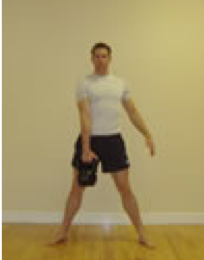
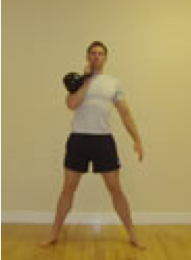
Muscles used
Glutes, Hamstrings, Erector spinae, Deltoids, Trapezius
Start position
Holding the kettlebell in one hand, swing it between the legs whilst pushing the backside to the rear.
Lifting phase
Drive your hips upwards and forwards, but as you swing the weight up into the rack position ensure the kettlebell doesn’t come too far away from your body. Doing so will mean the weight contacts your arm and/or wrist with some force. Maintain a strong, straight back throughout this movement.
Lowering phase
Roll the kettlebell back out away from your shoulder and allow momentum to swing it between the legs ready for the next repetition.
LIFT VARIATIONS
-
- Double clean
- Alternating cleans
- Clean to catch
- Side clean
4. Military press
This traditional exercise requires more stability through the shoulder joint when performed with a kettlebell.

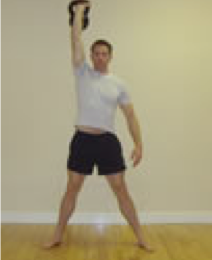
Muscles used
Deltoids
Triceps
Start position
Clean the kettlebell to the racking position.
Movement
Press the kettlebell overhead, then return to the start position.
LIFT VARIATIONS
-
- Double kettlebell military press
- Jerk
- Push press
5. Deadlift
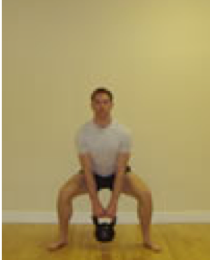
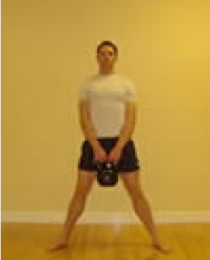
Muscles used
Glutes
Quads
Erector spinae
Start position
Stand with feet just over shoulder width apart, either side of the kettlebell. Place both hands on the handle.
Movement
Maintaining an upright back and the weight through the heels, drive the legs upwards, squeezing the glutes at the top of the movement. Return to the start position.
LIFT VARIATIONS
-
- Double kettlebell deadlift
If you would like to incorporate more kettlebell work into your workouts with your clients or classes, why not consider qualifying yourself with our circuits and kettlebell course. You can use your graduate voucher for this course and qualify in both circuits and kettlebells as a double whammy. Email admin@drummondeducation.com
